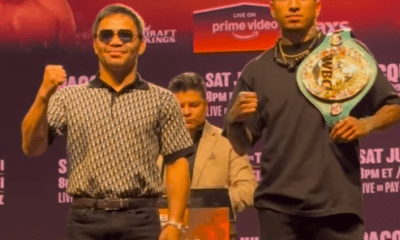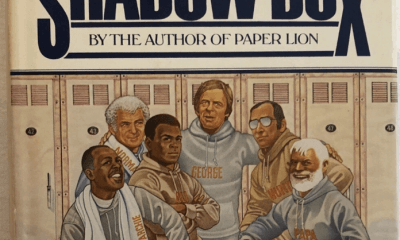Featured Articles
Floyd Mayweather: It Didn’t Happen By Accident
On October 11th 1996, Floyd Mayweather turned professional with a second round TKO over Roberto Apodaca, who was also making his pro debut. Here we are 17 years later and Floyd sports a career record of 44-0 (26) which is very impressive, and if he defeats Saul “Canelo” Alvarez 42-0-1 (30) this weekend, it’s pretty much a given he’ll retire undefeated based on who is out there qualified and in the running to meet him in the next two years.
Some probably marvel at the fact that he’s been undefeated for 17 years, something that wasn’t the luck of the draw in no way, shape or form. Sure, he’s managed himself brilliantly, but his boxing IQ and aptitude are just as impressive as his record. In addition to that, Floyd has never been out of shape for the duration of his career. Do you realize every time Mayweather started training for a fight, he never had to worry about his weight or conditioning. All he ever had to concentrate on was boxing and whoever the next opponent was. Unfortunately, a lot of world class fighters go into training and have to bust their ass just to get in shape and lose the necessary pounds just so they can make weight, then they focus on their craft and the opponent last.
Yet in regards to Mayweather, we’ve never really even seen him tired or gassed. A body that’s been in shape for 17 plus years like his must be strong in a boxing sense beyond imagination. Most fighters when they get in great shape brag about it. Not Mayweather. He brags about everything else except that. Like Bernard Hopkins, he doesn’t have to tell us about how great of shape he’s in, we already assume it.
The list of fighters who can say that is very short and Mayweather belongs on it every bit as much as Rocky Marciano, Marvin Hagler and Hopkins. Like them he runs and stays fit along with not ballooning up in weight between fights. Is it a coincidence that Marciano retired undefeated, Hagler was undefeated from 1976-1987 and Hopkins was undefeated from 1993-2005?
There are fighters around today and a multitude of them who’ve come before Floyd Mayweather who are/were more gifted, but didn’t or don’t work or think as hard as Floyd. That gives him a huge edge over everyone he fights. It’s interesting (to me anyway) that one of the problems Canelo will have to deal with is his not being in good enough shape to deal with Mayweather, who is 14 years his senior.
Think about all the temptations Mayweather has avoided since he’s been on top and it’s not like he leads a sedate life outside the ring. Yes, he’s had his run ins with law enforcement and has said and done some ridiculous things, like referring to an HBO contract as slave wages, but has there ever been even the slightest rumor about him drinking too much or him snorting or shooting something that he shouldn’t? If there has, I’ve never heard them. And do you know why that is? Because Mayweather, like him or not, takes boxing seriously.
On top of that, winning means something and is paramount to him. His ability to focus on what’s important is beyond comprehension. Like Hopkins, Mayweather grasped a long time ago that lazy losers and wannabes don’t get paid. Again, most marvel at his unblemished record, something that doesn’t blow me away because I believe if an in-their-prime Shane Mosley or Felix Trinidad fought every opponent Mayweather did on the night he fought them, they’d also be undefeated. What blows me away about Mayweather more than anything else is his lifelong dedication to boxing intelligence, which is really the things that have made him successful, not great natural talent. There have been a lot of fighters who were more physically gifted than Mayweather in the last 30 or 40 years.
Sugar Ray Leonard, Tony Ayala, Hector Camacho, Roy Jones and Mike Tyson were better prospects than Mayweather. Yet look at all he’s achieved. Actually, Joan Guzman is more physically gifted than Mayweather but isn’t nearly as accomplished.
In reality, Mayweather’s asset is skill plus will and a dedication and love for the sport of boxing. He’s taught himself and learned every aspect of the fight game in and out of the ring. How many other fighters not named Bernard Hopkins can that be said about? Some assume because Floyd isn’t a ‘walk in, take it to you’ type fighter that he’s not tough or strong, but you’re wrong, because he’s very tough and physically strong. He fought Miguel Cotto’s fight in the trenches because he wanted to, not because he was forced to. Floyd wanted to beat Miguel at his own game and won many of the exchanges on the inside due to his grit and physical strength. Had he chosen to box and counter he would’ve escaped with a much easier fight.
It was just eight years ago that Mayweather had to take the smaller purse in his first pay per view bout against Arturo Gatti. Up until fighting Gatti, Mayweather was a brash talking revolving title holder fighting on HBO. But he promised after Gatti, he’d only be seen on PPV and that’s basically been the case. In fact the only time he didn’t get the lion’s share of the purse is when he fought the real “Golden Boy” Oscar De La Hoya six years ago. Mayweather hasn’t just figured out where the X’s and the O’s go in the ring, he also figured out the business of boxing and what it took to pique interest in his fights. Mayweather realized that didn’t have the most fan-friendly style and that he could never be promoted and packaged as the kid next door like Sugar Ray Leonard or Oscar De La Hoya. So he figured he’d piss the fans off with his antics and words and willingly adopted the role of the bad guy (like in professional wrestling). This made him boxing enemy number one and he’s fed off of that and used it for motivation. And an overwhelming majority of fans wanted to and still want to see him lose – so they buy all of his fights so they can see it live and he laughs all the way to the Bugatti dealership.
And that folks, along with him always keeping them hanging on for the fights they want him to make, is a lot of the reason why he’s the most relevant, comprehensively covered and talked about athlete in combat sports worldwide. And like all else regarding Mayweather, that didn’t happen by accident. Like his in the ring strategy, it was well thought out and planned. It really has been something to watch over the last eight years. Mayweather studies the art of boxing, stays in great shape, resist all temptation that’s thrown his way, knows how to build and sell a fight and promotion, is very physically gifted and tough and knows what’s most important, winning. He’s never lost focus of that and for 17 years has done it his way. These things about Mayweather have to be admired and respected.
Also, if you’re a boxing purist, you must appreciate how Floyd has helped out other fighters who fell on hard times. He respects fighters and knows how tough the business is. He even paid for “Smokin” Joe Frazier’s funeral without being approached to do so, at least that I’m aware of. Look for for Mayweather to retire with his health, wealth, respect and title. Again, adding him to another short list of fighters who can make that claim. Love him or hate him, Floyd Mayweather is one of the more unique great fighters we’ve seen, and that didn’t happen by accident.
Frank Lotierzo can be contacted at GlovedFist@Gmail.com
-

 Featured Articles3 weeks ago
Featured Articles3 weeks agoAvila Perspective, Chap. 330: Matchroom in New York plus the Latest on Canelo-Crawford
-

 Featured Articles1 week ago
Featured Articles1 week agoVito Mielnicki Jr Whitewashes Kamil Gardzielik Before the Home Folks in Newark
-

 Featured Articles4 weeks ago
Featured Articles4 weeks agoAvila Perspective, Chap 329: Pacquiao is Back, Fabio in England and More
-

 Featured Articles3 weeks ago
Featured Articles3 weeks agoOpetaia and Nakatani Crush Overmatched Foes, Capping Off a Wild Boxing Weekend
-

 Featured Articles2 weeks ago
Featured Articles2 weeks agoCatching Up with Clay Moyle Who Talks About His Massive Collection of Boxing Books
-

 Featured Articles3 weeks ago
Featured Articles3 weeks agoFabio Wardley Comes from Behind to KO Justis Huni
-

 Featured Articles4 weeks ago
Featured Articles4 weeks agoDelving into ‘Hoopla’ with Notes on Books by George Plimpton and Joyce Carol Oates
-

 Featured Articles1 week ago
Featured Articles1 week agoMore Medals for Hawaii’s Patricio Family at the USA Boxing Summer Festival















